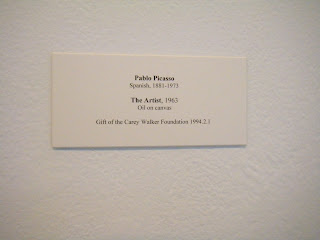
 Claude Monet, 1840 - 1926
Claude Monet, 1840 - 1926The Beach at Trouville
Oil on canvas, 1870
Upon arriving at the Wadsworth Atheneum the first thing I noticed was the beautiful, statuesque beauty of the building itself. The architecture is just gorgeous. After walking inside and beginning to explore, I found many pieces of art that I really liked but one of the paintings I found the most intriguing was Claude Monet’s oil on canvas painting called The Beach at Trouville. It is one of those pieces that puts you in the painting and makes you feel as if you are there with the subjects in the painting. I imagined myself back in time, strolling on the boardwalk, smelling the ocean air and feeling the sand beneath my feet. It is very hard to believe that painting if his, such as this one, were considered controversial, but I guess that was the way the culture was back then.
Claude Monet’s work is very distinctive because of his own unique technique of applying bright, unmixed colors in quick, short strokes (encarta.msn.com.) Claude Oscar Monet grew up in Le Havre on the Normandy coast the son of a successful tradesman in marine supplies. He was a leading figure in the late nineteenth-century impressionism, a movement in which painters looked to nature for inspiration and used vibrant light and color (www.encarta.msn.com, www.notablebiographies.com) in their paintings. He was known for capturing scenes from the middle class as well as nature.
Monet began to show his talent when he was teenager and began to get formal art training 1859 at the Académie Suisse, an art studio that provided models for aspiring artists but little direct instruction. Monet then went on to serve in the military and afterwards studied at a Parisian studio run by Charles Gabriel Gleyre in 1862. This studio was run by the students and also allowed students to draw or paint from models rather than plaster casts of Greek or Roman statues, which was a common teaching method at more conservative studios during this time. (encarta.msn.com)
Up until his death in 1926, Monet was working on paintings of water lilies, that he had begun in 1920 and were about fourteen feet wide, something he had never done before and was having problems doing because of his failing eyesight. (notablebiographies.com)
References:
http://encarta.msn.com/encyclopedia_761569820_2/Monet.htmlhttp://encarta.msn.com/encyclopedia_761569820_2/Monet.html
http://www.notablebiographies.com/Ma-Mo/Monet-Claude.html
I declare the honor pledge























































